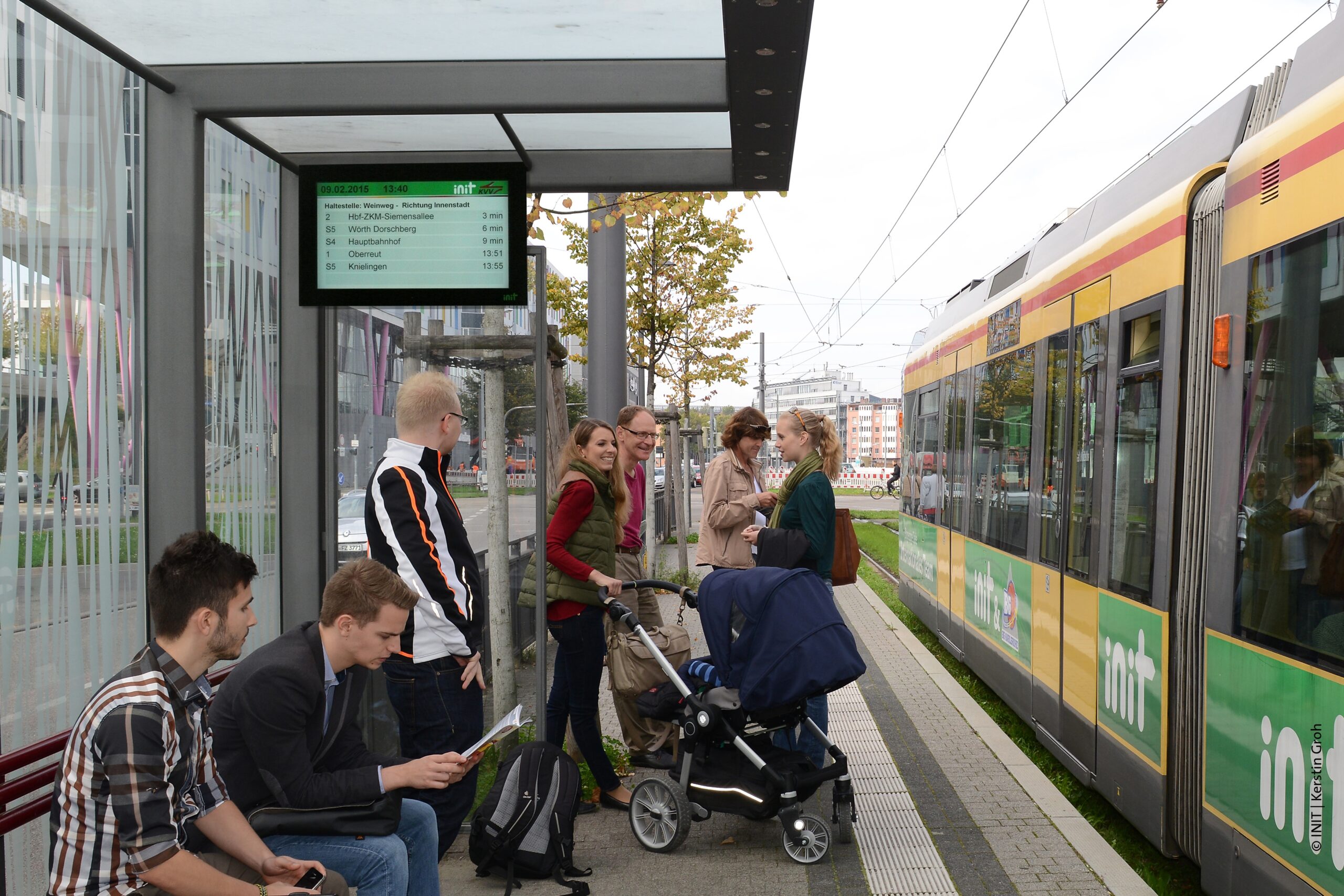The best solution for every disruption - Smooth public transport thanks to AI support for dispatchers
Motivation
In the control center of a transport company, dispatchers monitor the buses and trains with the help of control center software and thus monitor the situation in the entire local public transport system of a city or region. If disruptions occur (e.g. due to an accident), rails are blocked or vehicles are delayed, the dispatchers intervene to minimize the impact on passenger services. To do this, the dispatchers trigger so-called scheduling measures in the control center software. These take the form of detour, short turns or minor measures such as waiting for a delayed vehicle to enable passengers to change to another line without missing their connection.
In the event of a malfunction, the dispatchers have to react quickly and take many factors into account at the same time. They are therefore exposed to a very high level of stress and the complexity of many situations also requires a wide range of experience.
Objective
The aim of the use case led by INIT is to evaluate data on previous scheduling measures using artificial intelligence (AI) methods and, based on this, to develop a suggestion assistant that supports dispatchers in making difficult decisions. It is particularly important to design the assistant in such a way that it is tailored to the needs of the dispatcher and can be operated intuitively. Great importance is therefore attached to the user-friendliness and visualization of the AI-based assistant.
The AI is to be trained in such a way that it takes into account a large number of relevant factors and then proposes planning measures that are precisely adapted to the respective situation. This is intended to support the dispatchers in their decisions. In addition, the system is to be linked to the control center software in such a way that the dispatching measures are automatically triggered when the dispatchers accept the AI suggestion. It is therefore an AI-supported suggestion system that relieves the workload on dispatchers while giving them full control over the processes.
Approach
The partners are working to support dispatchers in their daily work with the control center software. The control center software is a very complex system and offers dispatchers many options that can be used in the event of an incident. The use case is initially limited to proposing selected dispositive measures on the basis of which the AI-based algorithms are developed. The historical-operational data from the control center software, which contains vehicle positions, timetable data and the respective scheduling measures triggered, serves as the starting point. The first step is to process the existing data and identify other necessary data before evaluating it using suitable AI processes and developing algorithms for the suggestion assistant. In order to ensure applicability and to take into account all factors to be included, surveys will also be conducted with the dispatchers of the Karlsruhe streetcar operators. Based on the Karlsruhe streetcar data, a prototype is developed, followed by an iterative analysis and further development.
Added value
The automated monitoring of buses and trains and the automated creation of recommendations for action regarding scheduling measures based on this support the dispatchers in their work and relieve their workload, especially in the event of disruptions. This enables them to make well-considered decisions that help to prevent errors and act more efficiently. The ability to automatically adapt timetable data and (partially) automate other downstream processes such as the creation of passenger information also contributes to improved working conditions and operational processes.
The best solution for every disruption - Smooth public transport thanks to AI support for dispatchers

Motivation
In the control center of a transport company, dispatchers monitor the buses and trains with the help of control center software and thus monitor the situation in the entire local public transport system of a city or region. If disruptions occur (e.g. due to an accident), rails are blocked or vehicles are delayed, the dispatchers intervene to minimize the impact on passenger services. To do this, the dispatchers trigger so-called scheduling measures in the control center software. These take the form of detour, short turns or minor measures such as waiting for a delayed vehicle to enable passengers to change to another line without missing their connection.
In the event of a malfunction, the dispatchers have to react quickly and take many factors into account at the same time. They are therefore exposed to a very high level of stress and the complexity of many situations also requires a wide range of experience.
Objective
The aim of the use case led by INIT is to evaluate data on previous scheduling measures using artificial intelligence (AI) methods and, based on this, to develop a suggestion assistant that supports dispatchers in making difficult decisions. It is particularly important to design the assistant in such a way that it is tailored to the needs of the dispatcher and can be operated intuitively. Great importance is therefore attached to the user-friendliness and visualization of the AI-based assistant.
The AI is to be trained in such a way that it takes into account a large number of relevant factors and then proposes planning measures that are precisely adapted to the respective situation. This is intended to support the dispatchers in their decisions. In addition, the system is to be linked to the control center software in such a way that the dispatching measures are automatically triggered when the dispatchers accept the AI suggestion. It is therefore an AI-supported suggestion system that relieves the workload on dispatchers while giving them full control over the processes.
Approach
The partners are working to support dispatchers in their daily work with the control center software. The control center software is a very complex system and offers dispatchers many options that can be used in the event of an incident. The use case is initially limited to proposing selected dispositive measures on the basis of which the AI-based algorithms are developed. The historical-operational data from the control center software, which contains vehicle positions, timetable data and the respective scheduling measures triggered, serves as the starting point. The first step is to process the existing data and identify other necessary data before evaluating it using suitable AI processes and developing algorithms for the suggestion assistant. In order to ensure applicability and to take into account all factors to be included, surveys will also be conducted with the dispatchers of the Karlsruhe streetcar operators. Based on the Karlsruhe streetcar data, a prototype is developed, followed by an iterative analysis and further development.
Added value
The automated monitoring of buses and trains and the automated creation of recommendations for action regarding scheduling measures based on this support the dispatchers in their work and relieve their workload, especially in the event of disruptions. This enables them to make well-considered decisions that help to prevent errors and act more efficiently. The ability to automatically adapt timetable data and (partially) automate other downstream processes such as the creation of passenger information also contributes to improved working conditions and operational processes.

Dr. Jochen Wendel
INIT GmbH
jwendel@initse.com









